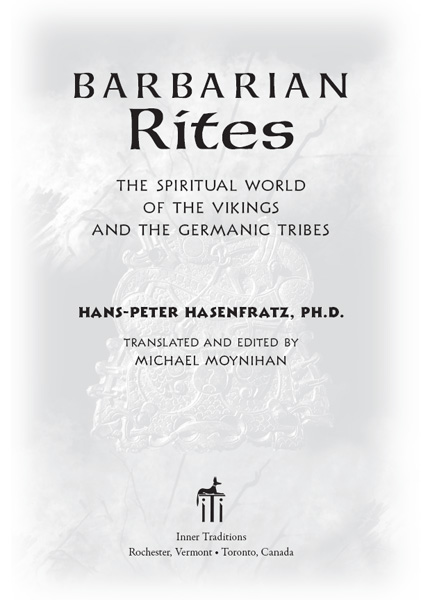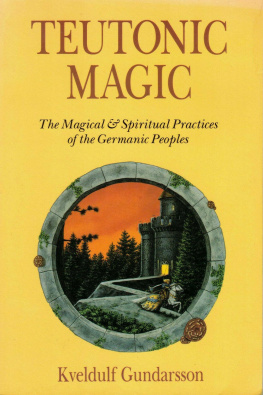
Barbarian Rites

Professor Hasenfratz presents both a solid introduction to the mysterious world of Germanic spirituality and something that goes well beyond the introductory as he demonstrates many deeper insights through his lively comparative and holistic approach.
STEPHEN E. FLOWERS, PH.D.,
DIRECTOR OF THE WOODHARROW INSTITUTE
AND AUTHOR OF THE SECRET OF THE RUNES
A number of books describe the pagan gods of the ancient Norsemen, but very few explain why pagan beliefs appealed to so many for so long. In this outstanding English translation of Barbarian Rites, Hasenfratz engages Germanic spiritual tradition seriously and empathetically. He provides an important and useful resource for students of northern European religions at all levels.
STEPHEN HARRIS, ASSOCIATE PROFESSOR OF GERMAN
AND SCANDINAVIAN STUDIES AT THE
UNIVERSITY OF MASSACHUSETTS, AMHERST
Translators Foreword
This volume is a translation of Hans-Peter Hasenfratzs study titled Die religise Welt der Germanen: Ritual, Magie, Kult, Mythus (The Religious World of the Germanic Peoples: Ritual, Magic, Cult, Myth). Since its original publication by Verlag Herder in 1992, the book has gone through numerous printings. In 2007 it was reissued as Die Germanen: Ritual, Magie, Kult, Mythus by Verlag HOHE.
Professor Hasenfratzs book fills an important niche in presenting a solid, streamlined introduction to ancient Germanic religious ideas and practices in their historical-cultural context. His text is well grounded in relevant scholarship, which he presents in a readily accessible manner. In contrast to any number of popular, neopagan, or overly subjective nonacademic books on Norse religion and the like, it is also thoroughly devoid of any romantic coloring. Hasenfratz is admirably cautious in dealing with the data that has been gained through the past few centuries of scholarship in archaic Germanic cultures. In this area there is much that is not known and will probably remain forever shrouded in mystery to some degree. Hasenfratz establishes from the outset how far apart contemporary Western civilization stands from these societies that existed one to two millennia ago. In his view, the best we might hope for is to be able to sketch a basic picture of older cultural ideas and practices and to gain an approximation of the distance that now lies between us and these very different older worlds.
In the past fifty years the most accomplished English-language scholarly monographs dealing with older Germanic religion and cult practices (such as E. O. G. Turville-Petres Myth and Religion of the North and various books by Hilda Ellis Davidson) have typically focused entirely on Viking Age Scandinavia. Though much of the material that Hasenfratz presents derives from medieval Scandinavian sources (which are often the most extensive and well preserved when it comes to pre-Christian Germanic myth and religion), he also frequently draws upon literary and historical sources from medieval Central Europe and Anglo-Saxon England to illustrate his points.
Barbarian Rites fills another rather unique niche in that it is written from the perspective of a scholar specializing in comparative religion and the history of religions. It is an interdisciplinary text that makes use of philology, historical linguistics, history, literature, mythology, anthropology, and occasionally folklore and archaeology. The text represents cultural studies in the best and most holistic sense of the term, and even seasoned scholars will undoubtedly find insights here that have not appeared elsewhere.
We should note a few things with regard to this English translation. In his original text Hasenfratz often points out etymological connections between older Germanic terms (preserved in the literary monuments of Gothic, Old High German, Middle High German, Old Norse, Old Saxon, and so on) and modern German. These elements of the book have been kept fully intact, but whenever possible I have also addedin the form of translators notes (these notes appear in brackets and are labeled Trans.)similar etymological parallels to modern English. Because English is as much a Germanic language as modern German, these parallels generally serve to illuminate the linguistic material in a very similar way. I have added other notes to clarify key technical terms in the text, explain the historical-linguistic background of matters discussed, and to expand upon references that might be unfamiliar to the reader.
When discussing material that derives from literary sources (such as Icelandic sagas or other medieval texts), Hasenfratz typically uses end notes to refer the reader to the relevant locations in German translations of these works. I have located parallel references in English for every such German reference, and I have included these in the notes ahead of the German citations. On the few occasions when there exists no parallel English translation, only the German citation appears. Perhaps some of these notes might inspire readers, especially students, to delve further into the cited translations of the original sources.
When Old Icelandic personal names are mentioned from the sagas and other sources, I have generally Anglicized these, as is now common in translations. Sigurr is therefore rendered Sigurd, Starkar as Starkad, angbrandr as Thangbrand, and so on. A few uncommon coinages have also been used, such as Ase for Old Icelandic ss, god, member of the divine class of the sir, and Wane for Old Icelandic vanr, member of the divine class of the Vanir. Another term that frequently turns up is Sib, used to describe the larger kingroup or clan of associated and interrelated families, which was a fundamental social structure in older Germanic cultures. More detailed explanations of such terms will be found in the text and notes.
In general I have kept intact the presentation and formatting of the original edition. When the author makes reference to specific words in older languages, and these terms are not proper nouns, they appear in italics and are typically glossed with their primary meaning in quotation marks. When older words appear with hyphenation, this is for the purpose of showing the etymological connections of their compound elements; in the original sources the words would have appeared in their natural compounded (unhyphenated) form. Words that appear with an asterisk before them are forms that are assumed to have existed during earlier, or proto, stages of the language (such as proto-Germanic or proto-Indo-European). These words are not attested in any written historical source, but they have been reconstructed to a reliable degree according to the science of comparative historical linguistics.
Various colleagues and friends have provided their gracious assistance in one way or another for this translation project. These include Craig Davis (professor at Smith College), Joscelyn Godwin (professor at Colgate University), and Stephen Harris and Rex Wallace (both professors at the University of Massachusetts). Joshua Buckley deserves deep thanks for his careful reading of an early draft of the translation and his helpful feedback. At Inner Traditions, Jon Graham has been of inestimable support and Mindy Branstetter an exemplary and conscientious editor. This translation might never have come about, however, without the input of James E. Cathey, professor emeritus in Germanic philology at the University of Massachusetts. It was he who first pointed me in the direction of Hasenfratzs original book. This gesture inadvertently planted the seed that has now borne fruit, some years later, in the form of this translation. Along the way, he provided many kindnesses and keen remarks for which I am most grateful.
Next page








